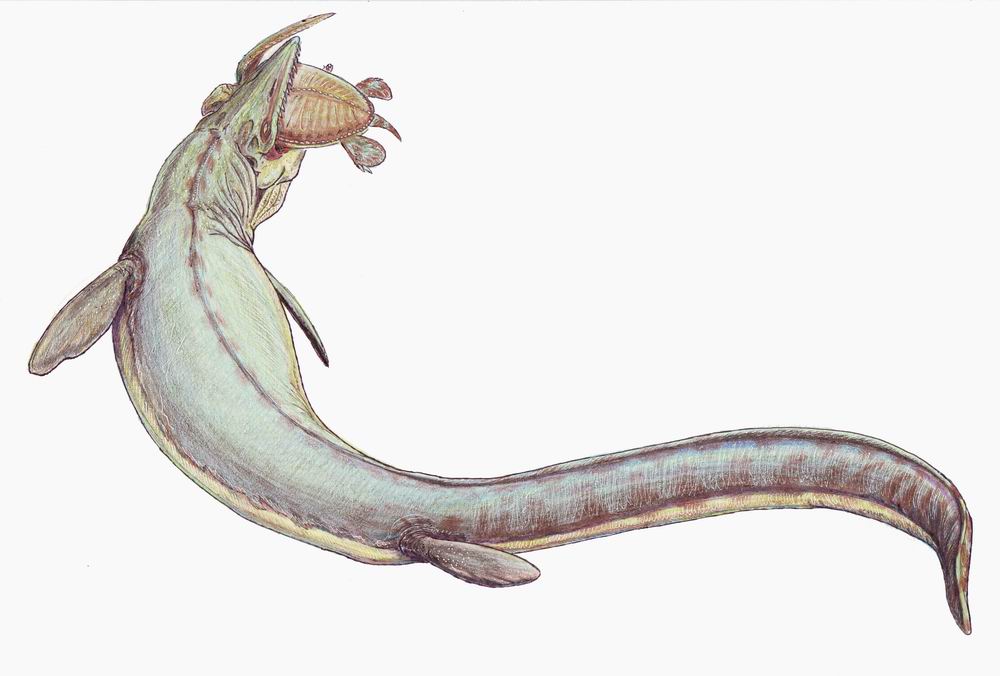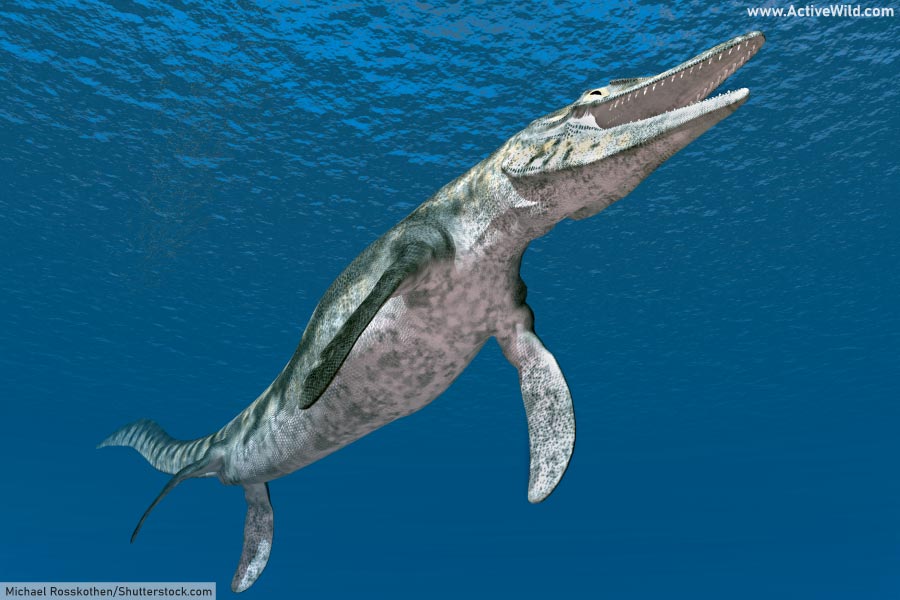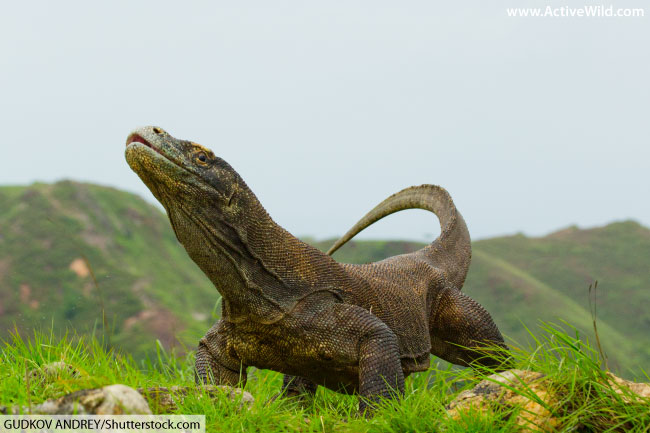Mosasaurs were the dominant marine predators of the late Cretaceous Period. With long jaws and powerful tails, they looked like a cross between a crocodile and a whale. Some mosasaurs were as big as whales, too–at 30-60 feet, the largest species were longer than all but the largest modern whales.
Page Index
- Mosasaurus
- Marine Lizards
- What Color Were Mososaurs?
- Did Mosasaurs Lay Eggs?
- Mosasaur Evolution
- Mosasaur Related Animals
- Mosasaurs Vs Wales
- Where Were Mosasaurs Found?
- When Did Mosasaurs Become Extinct?
- Further Reading & References
Mosasaurs looked like dinosaurs and lived at the same time, but they were only distant relatives. Mosasaurs’ closest living cousins are snakes and monitor lizards, whereas dinosaurs’ closest living relatives are their direct descendants: birds.
The name Mosasaur comes from “Mosa”, the Latin name for the Meuse river in the Netherlands. Some of the earliest mosasaur fossils were found there in the 18th century. (The second part of the name, “saur”, comes from the Greek word for “lizard”.)
Mosasaurus
One of the best-known types of Mosasaur is Mosasaurus.
In fact, Mosasaurus isn’t one species, but a genus containing a dozen or so different species; one of around 40 known mosasaur genera.
A mosasaurus played a prominent role in the movie Jurassic World, where it lived in a huge Sea World-style arena. The mosasaurus in the movie was big enough to eat a great white shark in a single bite – a slightly exaggerated, but not unrealistic, size.
The largest mosasaur species was probably Mosasaurus hoffmannii, an animal that ranged across what is now the Atlantic Ocean. It reached lengths of 30-60 feet (9.14-18.28 meters).
The smallest-known mosasaur is Dallasaurus turneri. This species, which belongs to a different genus than the mighty Mosasaurus hoffmannii, was under 1 m (3.3 ft.) in length. It lived in oceans surrounding North America.
Marine Lizards With Flippers
Mososaurs belong to a group of reptiles called Toxicofera, which includes snakes as well as monitor lizards and Komodo dragons.
The ancestor of the mosasaurs probably looked a lot like a modern Komodo dragon. It was likely a big, predatory lizard that lived on land but was also a strong swimmer and comfortable in the water.
Unlike the Komodo dragon, mosasaurs had flippers instead of feet, and were far too big to get around on land. They would have been completely bound to the water.
Like all reptiles, mosasaurs were air-breathers. They spent most of their time hunting underwater, but they would have had to surface every once in a while to breathe.
What Color Were Mososaurs?
While we can’t know exactly what mosasaurs looked like, we do know something about their coloration.
Scientists in 2014 analyzed the remains of a mosasaur and found traces of the dark pigment eumelanin, which produces black or dark brown colors in skin.
The researchers discovered that eumelanin was more concentrated on the animal’s back than its belly, suggesting that it had an overall pattern similar to an orca or a great white shark: dark on the back, white underneath.
This pattern is known as “countershading” and is actually very common in aquatic animals because it provides camouflage. Seen from above, the animal blends into the murky depths; seen from below, it blends into the sunlit surface.
The color pattern is interesting in its own right, but it also suggests something about how the animal hunted.
For the dark-over-white pattern to be effective, the animal has to be hunting in the upper parts of the water column, where sunlight is strong. Otherwise, the white belly wouldn’t do any good. So mosasaurs may have hunted in deep or shallow water but in either case they probably stayed pretty close to the surface.
Did Mosasaurs Lay Eggs?
Although most reptiles lay eggs, at least some mosasaurs appear to have given birth to live young.
Fossil predators are often found with small bones in their bellies, and usually scientists interpret those bones as the remains of a prey item. But in 2001 a team uncovered an exquisitely-preserved mosasaur fossil with four embryos preserved in its belly.
Live birth is uncommon in reptiles, but is often found in large aquatic predators, such as ichthyosaurs and today’s anacondas.
Mosasaur Evolution
In the Jurassic and Triassic periods, there were no mosasaurs. In these ancient seas, the dominant predators were two other groups of marine reptiles: the dolphin-like ichthyosaurs and the long-necked plesiosaurs.
About 100 million years ago, in the middle of the Cretaceous Period, the ichthyosaurs died out – the reasons are hotly debated by paleontologists, but it seems these fish-like reptiles ultimately lost the genetic lottery of evolution and didn’t develop suitable adaptations to keep up with ecological change.
The ichthyosaurs’ loss, though, was the mosasaurs’ gain. With fewer ichthyosaurs, there was a niche available for a large oceanic predator, and mosasaurs were well-placed to evolve into it.
In addition to the decline of the ichthyosaurs, mosasaurs got a boost from changes in the Earth’s climate. As the planet got warmer, sea levels rose and gradually flooded much of the land. So there was less and less terrestrial habitat, and more and more aquatic habitat to move into.
Mosasaur Facts: Related Animals
Although mosasaurs, ichthyosaurs, and plesiosaurs were all large aquatic predators of the Cretaceous, they weren’t closely related. Plesiosaurs were cousins of modern turtles, not lizards, and ichthyosaurs’ place on the tree of life is still uncertain.
As for the mosasaurs, they evolved, as we’ve seen, from an ancestor that looked something like a monitor lizard or a small Komodo dragon. One possible ancestor, Dallasaurus, was discovered in Texas in 2005. It was small, maybe 3 feet long, and had a long body with short limbs and a strong tail for swimming. Dallasaurus would have been a good swimmer, but was also capable of getting around on land.
The tail was one of the mosasaurs’ key adaptations: it grew long and extremely powerful, and became the main source of propulsion. Mosasaurs got around by pumping their bodies from side to side just like monitor lizards and water snakes do today.
Because they spend so much time on land, monitor lizards can’t afford to have a big fluked tail – it would get in the way of walking. But as they became fully aquatic mosasaurs no longer needed to walk, so the tail got longer and stronger and developed flukes not unlike those of a whale.
Because reptiles swim by moving side-to-side rather than up-and-down, the mosasaurs developed vertical flukes. Their tails were upright like a shark’s tail, not horizontal like a whale’s.
The mosasaur’s flippers might have helped it gain speed, but their main role was probably steering. Some mosasaur species have small back flippers relative to the front flippers, so it’s possible that over time they might have lost the back flippers entirely, just like whales. But they went extinct before that evolutionary transition could take place.
Mosasaurs Vs Whales
It’s no accident that mosasaurs looked so much like whales. They followed a very similar evolutionary path. Like mosasaurs, whales descend from a four-legged, land-dwelling predator that probably specialized in hunting fish and other aquatic life near the shore. Over generations, this creature evolved to spend more and more time at sea, ultimately losing many of its adaptations to land.
Another commonality with whales is the mosasaurs’ size. On land, animals are constrained by gravity: big bodies are difficult to support and move around. But water buoys up an animal’s body, so there’s almost no limit to how big they can get. For mosasaurs and whales alike, a fully aquatic lifestyle opened the door to immense body size.
Mosasaurs shared the ocean with sharks, which had already been around for hundreds of millions of years. No Cretaceous shark was as big as a Mosasaurus hoffmanni, but there would have been plenty of sharks to complete with the smaller mosasaur species.
Where Were Mosasaurs Found?
Mosasaurs were found all over the world, including Antarctica. In the warm climate of the late Cretaceous, all of the world’s oceans were suitable feeding grounds. And like today’s great white sharks, the mosasaurs ranged over huge distances looking for suitable prey.
Mosasaurs lived in the open ocean, where they could find prey suitable to their massive size. But a group of paleontologists discovered in 2012 that there were freshwater mosasaurs as well. They called the new species Pannoniasaurus inexpectatus, meaning “The unexpected lizard from the ancient continent of Pannonia” – unexpected because the surrounding sediments proved it lived in fresh water, where no mosasaur had ever been found before.
If Mosasaurus hoffmanii was like a colossal orca of the Cretaceous seas, Pannoniasaurus inexpectatus was like a river dolphin – smaller and more maneuverable, better suited to shallow water.
When Did Mosasaurs Become Extinct?
Mosasaurs went extinct 66 million years ago along with dinosaurs, pterosaurs, and nearly all the large reptiles.
All these animals were victims of the catastrophic Chicxulub impact event, which wiped out every living thing in its vicinity and then brought about sudden and permanent changes in the climate.
Because mosasaurs were so widespread, it probably took a while for them to go completely extinct – small pockets may have survived in a few places. But eventually they all died out completely, and the niche of large oceanic predator was once again left open, to be filled eventually by a resurgence of giant sharks, mammalian predators like whales and sea lions, and ultimately, in the last few hundred generations, by human beings with boats and nets.
Further Reading & References
- Cretaceous Period Animals That Weren’t Dinosaurs
- The Cretaceous Period Facts: The Ultimate Guide To The Third & Final Period Of The Mesozoic Era
- When Was The Cretaceous Period & How Long Did It Last? Your Cretaceous Questions Answered!
- Cretaceous Period Dinosaurs List With Pictures & Facts: Discover The Dinosaurs That Lived In The Cretaceous Period
References
Bell, G. L., and M. J. Polcyn. "Dallasaurus turneri, a new primitive mosasauroid from the Middle Turonian of Texas and comments on the phylogeny of Mosasauridae (Squamata)." Netherlands Journal of Geosciences 84.3 (2005): 177-194.
Caldwell, Michael W., and Michael SY Lee. "Live birth in Cretaceous marine lizards (mosasauroids)." Proceedings of the Royal Society of London. Series B: Biological Sciences 268.1484 (2001): 2397-2401.
Lingham-Soliar, Theagarten. "Anatomy and functional morphology of the largest marine reptile known, Mosasaurus hoffmanni (Mosasauridae, Reptilia) from the Upper Cretaceous, Upper Maastrichtian of the Netherlands." Philosophical Transactions of the Royal Society of London. Series B: Biological Sciences 347.1320 (1995): 155-180.
Makádi, László, Michael W. Caldwell, and Attila Ősi. "The first freshwater mosasauroid (Upper Cretaceous, Hungary) and a new clade of basal mosasauroids." PLoS One 7.12 (2012): e51781.
Perkins, Sid. “The True Color of Ancient Sea Creatures.” Science Magazine. 8 January, 2014.









this is so good thank you for making this!!!!!!!!!!!!!!